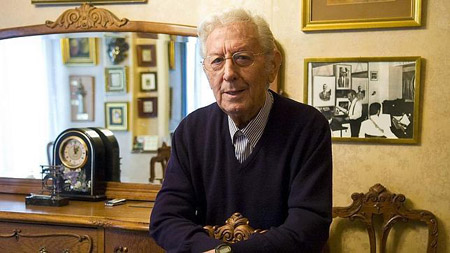
Carlos
Munguía
(1921—2012)
With the death of Carlos Munguía, in his native San Sebastián (Donostia) at the age of ninety, one of the most important links with the golden years of zarzuela recording is severed. Many lovers of the genre will be familiar with the distinctive, particularly Spanish plangency of his tenor voice: his excellent diction, lyric fire and strong sense of theatre graced over thirty LP recordings – many of them under the baton of Ataúlfo Argenta, and often in tandem with soprano Ana-María Iriarte – and most of these are still available in today’s CD catalogue.
Born on 4th November 1921, Munguía grew up (like many Basque singers) with the Orfeón Donostiarra, the choral society which was and still is the musical symbol of the city of San Sebastián, and which he joined aged 17. He soon became a soloist, but continued to subsidise his singing by working as an industrial procurement manager. His first major break came in 1950, when he played a small role in the premiere of Ángel Barrios’s opera La Lola se va a los puertos at the Liceu in Barcelona. Soon he was in demand as a leading soloist in opera house and concert hall alike, working with conductors such as Jean Fournet and Jesús Arámbarri in staple choral repertory such as Berlioz’s Damnation of Faust and the Verdi Requiem.
He met Ataúlfo Argenta in 1953, singing the Prize Song from Die Meistersinger under him in a San Sebastián concert, and from that time he became the conductor’s tenor of choice in the recording studio. Aside from many complete zarzuela recordings – amongst which Los de Aragón, El caserío, El dúo de la Africana, La picarona and Moros y cristianos may be singled out for special praise – Munguía also played the title role in Argenta’s recording of de Falla’s opera El retablo de Maese Pedro, a classic LP which introduced that masterpiece to many people outside Spain.
 He was a particular champion of
his sadly short-lived Basque compatriot Usandisaga, performing in revivals of
all that composer’s stage works including Mendi Mendiyan and
La llama as well as Las golondrinas; whilst his Spanish stage
career focused on opera rather than zarzuela, with Gounod’s Faust (as
well as the Berlioz), Alfredo in La Traviata and Turiddu in
Cavalleria Rusticana amongst his most demanded roles. He also played
Cassio in a San Sebastián Otello opposite Mario del
Monaco’s moor. 1956 witnessed a famous Doña Francisquita
revival at Teatro de la Zarzuela, where he alternated the role of Fernando with
the young Alfredo Kraus. In later years, as his voice mellowed, he specialised
in the Viennese operetta repertoire, also joining Jose Tamayo’s famous
zarzuela touring show with great success.
He was a particular champion of
his sadly short-lived Basque compatriot Usandisaga, performing in revivals of
all that composer’s stage works including Mendi Mendiyan and
La llama as well as Las golondrinas; whilst his Spanish stage
career focused on opera rather than zarzuela, with Gounod’s Faust (as
well as the Berlioz), Alfredo in La Traviata and Turiddu in
Cavalleria Rusticana amongst his most demanded roles. He also played
Cassio in a San Sebastián Otello opposite Mario del
Monaco’s moor. 1956 witnessed a famous Doña Francisquita
revival at Teatro de la Zarzuela, where he alternated the role of Fernando with
the young Alfredo Kraus. In later years, as his voice mellowed, he specialised
in the Viennese operetta repertoire, also joining Jose Tamayo’s famous
zarzuela touring show with great success.
As late as 1986 he sang the solo tenor part in Mozart’s Requiem, a staple from the very start of his career, retiring soon afterwards to his native city where he died on 20th February. His breathing technique was not above criticism, sometimes affecting vocal support and consequently pitch; and his characteristic portamento con slancio style manifest throughout his recording career was never to everyone’s taste. Much more important than these were his unmistakable nasal, but far from lightweight and always pleasant tone; and his unfailing sense of character, energy and musical good taste. These are the qualities which continue to make his recordings a listening pleasure which will keep his memory green for generations to come.
CW, 13/IXV/2012